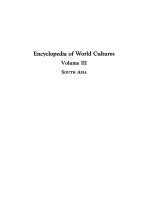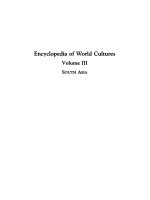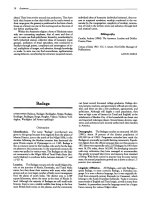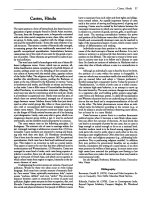Encyclopedia of World Cultures Volume III - South Asia - O doc

Encyclopedia of World Cultures Volume III - South Asia - O doc
... Puri
and
Ganjam
districts,
with
houses
almost
in
a
continuous
chain
on
both
sides
of
the
intervening
village
path
and
with
kitchen
gardens
at
the
back
of
the
houses.
Cultivated
fields
surround
the
settlement.
In
the
cluster
pattern
each
house
has
a
compound
with
fruit
trees
and
a
kitchen
garden.
The
Scheduled
Castes
live
in
lin.
ear
or
cluster
hamlets
slightly
away
from
the
main
-settleme...

Encyclopedia of World Cultures Volume III - South Asia - A doc
... that
life
continues
be-
yond
the
grave,
in
a
land
where
each
of
the
uyus
has
its
indi-
vidual
abode.
When
one
dies,
his
or
her
soul
is
taken
to
the
domain
of
the
uyu
who
was
the
cause
of
death.
An
individual
enjoys
the
same
status
and
life-style
that
he
or
she
had
while
alive.
For
this
reason
the
deceased
is
provided
with
food,
drink,
possessions,
and
other
tools
and
provisions
to
ensur...

Encyclopedia of World Cultures Volume III - South Asia - J docx
... a
very
large
proportion
of
the
population.
Industrial
Arts
and
Division
of
Labor.
Among
the
agri-
cultural
Jat,
traditionally
only
the
men
work
in
the
fields,
Jain
109
prime
responsibility
for
digging
the
grave,
but
the
Kurumba
present
also
assists.
When
all
is
ready,
the
body
is
placed
in
the
grave
so
that
it
faces
toward
the
north.
The
local
Irula
priest
(pujari)
then
gazes
at
a
lamp
an...

Encyclopedia of World Cultures Volume III - South Asia - K doc
... Crooke.
1920.
London:
Oxford
University
Press.
Numerous
reprints.
PAUL
HOCKINGS
Tyler,
Stephen
A.
(1972).
"Fields
Are
for
Planting:
Notes
on
Koya
Agriculture."
In
Proceedings
of
the
Seminar
on
Tribal
Studies,
edited
by
D.
P.
Sinha.
New
Delhi:
Government
of
India
Press.
STEPHEN
A.
TYLER
Kurumbas
Kshatriya
ETHNONYMS:
Alu-Kurumbas,
Betta-Kurumbas,
Jenu-Ku-
rumbas,
Kurubas,
Mudugas,...

Encyclopedia of World Cultures Volume III - South Asia - S doc
... own
paddy
land,
marriage
(sidrung)
may
be
arranged
and
a
bride-price
paid
in
buffalo
or
labor.
But
most
marriages
are
by
free
choice
(dari)
with
no
payment.
A
woman
and
a
man
simply
set
up
house
together,
though
this
often
provokes
difficulties
with
their
families.
Girls
have
considerable
freedom
to
initiate
relationships.
Marriages
are
unstable
in
the
early
years
and
divorce
is
com-
mon.
Mar...

Encyclopedia of World Cultures Volume III - South Asia - Overview pot
...
Contents
Project
Staff
vi
Contributors
vii
Preface
xiii
Introduction
xix
Maps
1.
South
Asia
xxviii
2.
Cultural
Regions
of
South
Asia
xxix
3.
Major
Languages
of
South
Asia
xxx
4.
Dominant
Religious
Groups
of
South
Asia
xxxi
5.
Cultural
Groups
of
South
Asia
xxxii
Cultures
of
South
Asia
1
Appendix:
Additional
Castes,
Caste
Clusters,
and
Tribes
309
Bibliograph...

Encyclopedia of World Cultures Volume III - South Asia - B potx
... that
in
Bilaspur
they
adopted
Chhattisgarhi,
in
Mandla
and
Jub-
bulpore
they
spoke
a
modified
Eastern
Hindi,
in
Balaghat
they
spoke
Marathi,
Hindi,
Gondi
(or
a
combination
of
Marathi,
Hindi,
and
Gondi),
and
Baigani
(a
language
of
Indo-Aryan
Stock
belonging
to
the
Indo-European
Phylum).
History
and
Cultural
Relations
Baiga
contact
with
other
peoples
and
knowledge
of
regions
beyond
their...

Encyclopedia of World Cultures Volume III - South Asia - C ppt
... to
the
government.
The
Chakma
raja
traditionally
received
a
small
portion
of
tax
on
swidden
land.
Kinship
Kin
Groups
and
Descent.
The
paribar
(family)
is
the
basic
kinship
unit
in
Chakma
society.
Beyond
the
paribar
and
bari
(homestead),
multihousehold
compounds
are
the
next
widest
unit,
the
members
of
which
may
form
work
groups
and
help
each
other
in
other
activities.
Next
are
the
hamlets...

Encyclopedia of World Cultures Volume III - South Asia - D,E,F doc
... old
culture
is
comprised
of
three
main
layers:
the
Tamil-Malayalam
substratum
with
its
many
subtle
roots;
old
Sinhala
culture
and
language,
which
is
the
dominant
element;
and
the
phase
of
Arabic
in-
fluence.
But
the
Maldives
were
touched
by
every
cultural
wind
that
passed
over
the
Indian
Ocean.
Since
independence
there
has
again
been
influence
from
Sri
Lanka,
through
its
teachers
brought...

Encyclopedia of World Cultures Volume III - South Asia - G pot
... is
governed
by
repre-
sentatives
elected
by
universal
adult
franchise
who
constitute
a
vidhan
sabha
(legislative
assembly).
A
majority
party
forms
the
government.
The
head
of
the
state
is
the
governor,
ap-
pointed
by
the
president
of
India.
The
state
government
has
very
wide
powers
for
maintaining
law
and
order,
levying
taxes,
and
carrying
out
development
work.
It
also
shares
resources
wi...
Từ khóa:
- the gale encyclopedia of genetic disorders volume 1
- encyclopedia of medical anthropology volume 2
- top 10 beautiful cities of south asia
- encyclopedia of medical anthropology health and illness in the worlds cultures
- encyclopedia of medical anthropology health and illness in the worlds cultures topics
- bon more than 30 kilometres to the south of da nang occupied by early western traders hoi an was one of the major old time commercial ports of south asia in the 16th century
- 1961 systema helminthum the nematodes of vertebrates volume iii 1 2 interscience publishers inc new york
- epidemiology surveillance and laboratory diagnosis of leptospirosis in the who south east asia region
- the cambridge history of russia volume iii the twentieth century
- grades gradients and geography a dental morphometric approach to the population history of south asia
- south asia and management of energy security
- using the adaptation policy framework to assess climate risks and response measures in south asia the case of floods and droughts in bangladesh and india
- ebook the works of guy de maupassant volume iii of 8 by guy de maupassant
- formosat 2 images in mapping of south asia tsunami disaster
- djf left and wet season jja right precipitation for rcp2 6 2ºc world top and rcp8 5 4ºc world bottom for south asia by 2071 2099 relative to 1951 1980
- Nghiên cứu sự biến đổi một số cytokin ở bệnh nhân xơ cứng bì hệ thống
- Báo cáo quy trình mua hàng CT CP Công Nghệ NPV
- Nghiên cứu tổ hợp chất chỉ điểm sinh học vWF, VCAM 1, MCP 1, d dimer trong chẩn đoán và tiên lượng nhồi máu não cấp
- Nghiên cứu vật liệu biến hóa (metamaterials) hấp thụ sóng điện tử ở vùng tần số THz
- Biện pháp quản lý hoạt động dạy hát xoan trong trường trung học cơ sở huyện lâm thao, phú thọ
- Giáo án Sinh học 11 bài 13: Thực hành phát hiện diệp lục và carôtenôit
- Giáo án Sinh học 11 bài 13: Thực hành phát hiện diệp lục và carôtenôit
- Giáo án Sinh học 11 bài 13: Thực hành phát hiện diệp lục và carôtenôit
- ĐỒ ÁN NGHIÊN CỨU CÔNG NGHỆ KẾT NỐI VÔ TUYẾN CỰ LY XA, CÔNG SUẤT THẤP LPWAN
- Quản lý hoạt động học tập của học sinh theo hướng phát triển kỹ năng học tập hợp tác tại các trường phổ thông dân tộc bán trú huyện ba chẽ, tỉnh quảng ninh
- Phát triển mạng lưới kinh doanh nước sạch tại công ty TNHH một thành viên kinh doanh nước sạch quảng ninh
- Phát hiện xâm nhập dựa trên thuật toán k means
- Nghiên cứu tổng hợp các oxit hỗn hợp kích thƣớc nanomet ce 0 75 zr0 25o2 , ce 0 5 zr0 5o2 và khảo sát hoạt tính quang xúc tác của chúng
- Nghiên cứu khả năng đo năng lượng điện bằng hệ thu thập dữ liệu 16 kênh DEWE 5000
- Tìm hiểu công cụ đánh giá hệ thống đảm bảo an toàn hệ thống thông tin
- Sở hữu ruộng đất và kinh tế nông nghiệp châu ôn (lạng sơn) nửa đầu thế kỷ XIX
- Kiểm sát việc giải quyết tố giác, tin báo về tội phạm và kiến nghị khởi tố theo pháp luật tố tụng hình sự Việt Nam từ thực tiễn tỉnh Bình Định (Luận văn thạc sĩ)
- Quản lý nợ xấu tại Agribank chi nhánh huyện Phù Yên, tỉnh Sơn La (Luận văn thạc sĩ)
- chuong 1 tong quan quan tri rui ro
- Giáo án Sinh học 11 bài 14: Thực hành phát hiện hô hấp ở thực vật